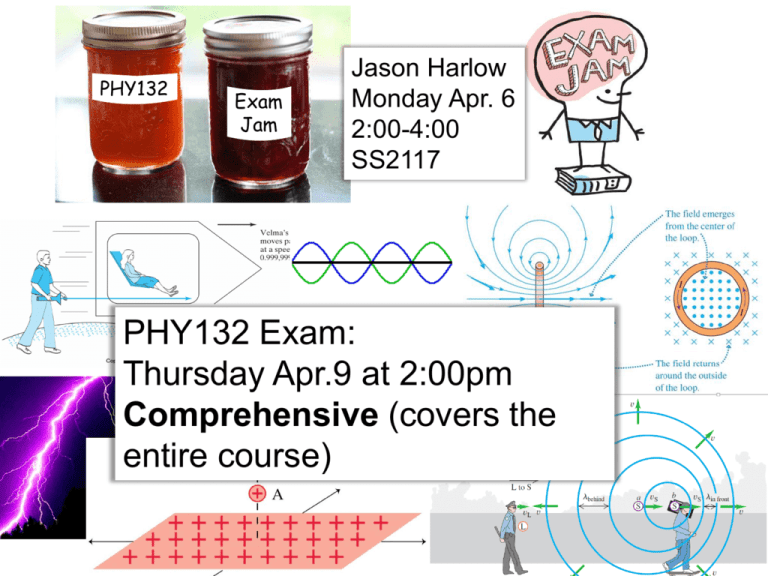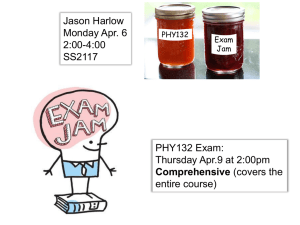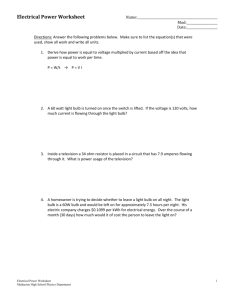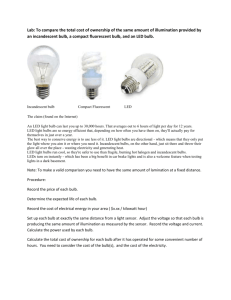PPTX
advertisement

PHY132 Exam Jam Jason Harlow Monday Apr. 6 2:00-4:00 SS2117 PHY132 Exam: c Thursday Apr.9 at 2:00pm Comprehensive (covers the entire course) The Final Exam Course Last Name Date Time Location PHY132H1S A - LE THU 09 APR PM 2:00 - 4:00 EX 100 PHY132H1S LI - W THU 09 APR PM 2:00 - 4:00 EX 200 PHY132H1S X - Z THU 09 APR PM 2:00 - 4:00 EX 320 • EX is Central Exams Facility, 255 McCaul St. (just south of College St.) Aids Allowed on the Final Exam • Any calculator without communication capability. • Aid sheet: one single, original, handwritten 8 1/2 × 11 inch sheet of paper, which may be written on both sides. • A ruler. • A paper copy of an English translation dictionary. • Also: During the Exam • Exam begins at 2:00pm SHARP!!! • Skim over the entire exam from front to back before you begin. Look for problems that you have confidence to solve first. • If you start a problem but can’t finish it, leave it, make a mark on the edge of the paper beside it, and come back to it after you have solved all the easy problems. • When you are in a hurry and your hand is not steady, you can make little mistakes; if there is time, do the calculation twice and obtain agreement. • Bring a snack or drink. • Don’t leave an exam early! No phones! No Apple Watch! No Google Glasses! From April 2014 Final Exam Let’s review. The Doppler effect: Moving listener • An observer moving toward a stationary source hears a frequency that is higher than the at-rest frequency f0. 𝑣𝑜 The Doppler effect: Moving source • When a source is moving away from an observer, the waves behind the source are stretched to a longer wavelength. • Since f = v/λ, a longer wavelength corresponds to a lower frequency. 𝑣𝑜 The Doppler Effect The frequencies heard by a stationary observer when the sound source is moving at speed v0 are The frequencies heard by an observer moving at speed v0 relative to a stationary sound source emitting frequency f0 are From April 2014 Final Exam From April 2014 Final Exam Let’s review. Thin-Film Optical Coatings • • Thin transparent films, placed on glass surfaces, such as lenses, can control reflections from the glass. Antireflection coatings on the lenses in cameras, microscopes, and other optical equipment are examples of thin-film coatings. When the index of a film is less than the index of the material beyond it (ie glass), then the halfcycle phase shift occurs for both reflections, and the wavelengths of constructive and destructive interference were as mentioned in class: 2𝑛film 𝑑 𝜆𝐶 = 𝑚 = 1, 2, 3, … 𝑚 𝜆𝐷 = 2𝑛film 𝑑 𝑚 − 12 𝑚 = 1, 2, 3, … When the index of a film is greater than the index of the material beyond it (ie glass), then the halfcycle phase shift occurs for the front surface, but not the back-surface of the film. This flips the constructive vs destructive equations: 𝜆𝐶 = 2𝑛film 𝑑 𝑚− 1 2 𝑚 = 1, 2, 3, … 2𝑛film 𝑑 𝜆𝐷 = 𝑚 = 1, 2, 3, … 𝑚 From April 2014 Final Exam air water A fish swims directly below the surface of the water. An observer sees the fish at: A. a greater depth than it really is. B. its true depth. C. a smaller depth than it really is. The Electric Field A charged particle with charge q at a point in space where the electric field is experiences an electric force: If q is positive, the force on the particle is in the direction of . The force on a negative charge is opposite the direction of . The units of the electric field are N/C. The magnitude E of the electric field is called the electric field strength. QuickCheck 26.9 Two protons, A and B, are next to an infinite plane of positive charge. Proton B is twice as far from the plane as proton A. Which proton has the larger acceleration? A. Proton A. B. Proton B. C. Both have the same acceleration. A Plane of Charge Capacitors The figure shows two electrodes, one with charge Q and the other with Q placed face-toface a distance d apart. This arrangement of two electrodes, charged equally but oppositely, is called a capacitor. Capacitors play important roles in many electric circuits. Motion of a Charged Particle in an Electric Field Consider a particle of charge q and mass m at a point where an electric field E has been produced by other charges, the source charges. The electric field exerts a force Fon q qE. From April 2014 Final Exam From April 2014 Final Exam The Electric Potential Inside a Capacitor The electric potential inside a capacitor is where s is the distance from the negative electrode. The potential difference VC, or “voltage” between the two capacitor plates is Units of Electric Field If we know a capacitor’s voltage V and the distance between the plates d, then the electric field strength within the capacitor is: This implies that the units of electric field are volts per meter, or V/m. Previously, we have been using electric field units of newtons per coulomb. In fact, these units are equivalent to each other: 1 N/C 1 V/m From April 2013 Final Exam In class discussion question What total potential difference (VB – VA) is created by these three batteries? B A A.1.0 V B.2.0 V C.5.0 V D.6.0 V E. 7.0 V The point: • Electric Potential is a property of space. • Every point has a certain value, and it must change from one side of a battery to another by its emf. • Also, V is higher on the + side of a battery. V=+3V A Define this point to be V=0 V=+2V V=+5V B Definition of Current If Q is the total amount of charge that has moved past a point in a wire, we define the current I in the wire to be the rate of charge flow: The SI unit for current is the coulomb per second, which is called the ampere. 1 ampere = 1 A = 1 C/s. Resistance and Ohm’s Law The SI unit of resistance is the ohm. 1 ohm = 1 Ω = 1 V/A. The current through a conductor is determined by the potential difference ΔV along its length: Circuit Diagrams Real life: A circuit diagram: Series Resistors • Resistors that are aligned end to end, with no junctions between them, are called series resistors or, sometimes, resistors “in series.” Parallel Resistors • Resistors connected at both ends are called parallel resistors or, sometimes, resistors “in parallel.” From April 2014 Final Exam Some quick notes about circuits: • “Electric Potential Difference” and “Voltage” mean the same thing. • We speak of voltage “across” a resistor, and current “through” a resistor. • Two points connected by an ideal wire always have the same potential. (A wire is an equipotential.) Variation on April 2014 Final Exam Demonstration. Two ways of wiring two different light bulbs. Note: A circle with a wavy line in it represents an Alternating Current (AC) power supply. It is like a battery, except the voltage flips direction 60 times per second. Demonstration. In Class Discussion Question If the bulbs are wired in parallel , which bulb will consume more power? A. The 60 W bulb. B. The 100 W bulb. C. both will consume the same power. Demonstration. In Class Discussion Question If the bulbs are wired in parallel , which bulb will consume more power? A. The 60 W bulb. B. The 100 W bulb. C. both will consume the same power. • The labels on the bulbs advertise the power assuming 120 V. • Voltage across each bulb is the same: 120 V • P = V 2/R • So the larger the resistance, the lower the power. • This means R60W > R100W Demonstration. In Class Discussion Question If the bulbs are wired in series, which bulb will consume more power? A. The 60 W bulb. B. The 100 W bulb. C. both will consume the same power. Demonstration. In Class Discussion Question If the bulbs are wired in series, which bulb will consume more power? A. The 60 W bulb. B. The 100 W bulb. C. both will consume the same power. • Current through each bulb is the same. • P=I2R • So the larger the resistance, the larger the power. • Recall: R60W > R100W • So this means: P60W > P100W Demonstration. The moral: - The thing that is the same for resistors in parallel is voltage. Use P = V 2 / R to compare power. Higher power corresponds lower resistance. - The thing that is the same for resistors in series is current. Use P = I 2 R to compare power. Higher resistance corresponds to higher power. - In your house, Parallel is always used. Demonstration. In Class Discussion Question. If the bulbs are wired in series and the 100 W bulb is unscrewed, what will happen to the 60 W bulb? A. It will light up. B. It will not light up. Demonstration. In Class Discussion Question If the bulbs are wired in parallel and the 100 W bulb is unscrewed, what will happen to the 60 W bulb? A. It will light up. B. It will not light up. From April 2014 Final Exam Let’s review. Right-hand rule for magnetic fields The strength of the uniform magnetic field inside a solenoid is where n = N/l is the number of turns per unit length. The Magnetic Force on a Moving Charge The magnetic force on a charge q as it moves through a magnetic field B with velocity v is where α is the angle between v and B. Right Hand Rule for Forces: From April 2014 Final Exam From April 2014 Final Exam Magnetic Force is important for fast moving electrons or positive ions in a vacuum. Since F tends to be perpendicular to v, it forms a good centripetal force. Mass Spectrometers use the fact that the radius of circular trajectory in a magnetic field depends on the mass of the particles. Cyclotron Motion: in 3D the motion of charged particles is not a circle but a spiral. The Earth’s magnetic field protects us from high energy charged particles from the Sun (beta, alpha radiation). Aurora Borealis is natural light caused by charged particles accelerating in the Earth’s magnetic field. From April 2014 Final Exam Let’s review. Principle of Constancy of Lightspeed The speed of light (and of other electromagnetic radiation) in empty space is the same for all observers, regardless of the motion of the light source or of the observer. v = 0.25 c c The light moves at speed c relative to Mort and relative to Velma. Do you really believe this?? v = 0.999,999 c c Even here, both Mort and Velma observe the speed of light to be c. Light Clocks A “light clock” is made up of two parallel mirrors, separated by a vacuum and held at a fixed distance of d. A short pulse of light bounces between the mirrors, “ticking” for each bounce. Twin Paradox Fred and George are identical, and so have identical lifespans. They each have a light clock. This light clock “ticks” once every millisecond, so they both expect to observe 2.5 × 1012 ticks in their 80 year life-span. Twin Paradox Fred flies on his broomstick to the right at 20% of the speed of light. George stays on the ground. Fred Over his life, George sees 2.5 × 1012 ticks of his stationary clock. How many “ticks” of Fred’s clock does George observe? A. More than 2.5 × 1012 B. Fewer than 2.5 × 1012 C. 2.5 × 1012 George Twin Paradox Fred flies on his broomstick to the right at 20% of the speed of light. George stays on the ground. Fred After George sees 2.5 × 1012 ticks of his stationary clock, he dies of old age. How do you expect his twin brother is doing? A. Fred will also probably die at this time. B. Fred has more life to live. C. Fred has already been dead for some time. George Twin Paradox Fred flies on his broomstick to the right at 20% of the speed of light. George stays on the ground. According to Fred, in his reference frame, he is stationary, and his brother is moving to the left at 20% of the speed of light. George Over his life, Fred sees 2.5 × 1012 ticks of his clock, which is stationary relative to him. How many “ticks” of George’s clock does Fred observe? A. More than 2.5 × 1012 B. Fewer than 2.5 × 1012 C. 2.5 × 1012 Fred Time Dilation The time interval between two events that occur at the same position is called the proper time Δτ. In an inertial reference frame moving with velocity v = βc relative to the proper time frame, the time interval between the two events is The “stretching out” of the time interval is called time dilation. From April 2014 Final Exam Good Luck!! • I’ll see you on Thursday at 2:00pm!! • Then I hope to see you again in the future – please say hi if you see me around campus, and feel free to stop by my office any time you see my open door. • It’s been a lot of fun teaching you physics this year – have a fantastic rest of your life!!!! Course Last Name Date Time Location PHY132H1S A - LE THU 09 APR PM 2:00 - 4:00 EX 100 PHY132H1S LI - W THU 09 APR PM 2:00 - 4:00 EX 200 PHY132H1S X - Z THU 09 APR PM 2:00 - 4:00 EX 320






